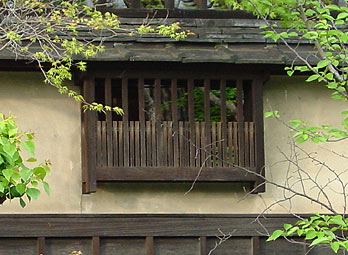|
||
 |
||

Old
Oohara 大原 house (Okayama)
(C)2001 Japanese Architecture and Art Net Users System. No reproduction or republication without written permission.
掲載のテキスト・写真・イラストなど、全てのコンテンツの無断複製・転載を禁じます。
|
||||||
| hijirimado 聖窓 | ||||||
| KEY WORD : architecture / general terms | ||||||
| A box-shaped, latticed window that often extended, demado 出窓, out from a building and was constructed at about eye level, beside the fence or entrance to a brothel, small shop or warrior's domicile during the proto-modern period. Translucent paper was pasted on the inside. It served as a gate light and, to some extent, illuminated the road in front of the building. Other hijirimado were circular. One style had large horizontal muntins in the lattice *yorikimado 与力窓, others had only vertical muntins. Over time innumerable imaginative styles developed including lattice laid diagonally, laths placed to form interesting patterns, for example, several laths grouped horizontally, succeeded by widely placed lattice followed by another group. Sometimes two or three vertical laths were grouped at given intervals. Elaborately decorated diagonal laths also became common, especially on dwellings of the upper classes. The corner part of the window frame projected from the posts *houdate 方立, on each side. The bottom part of the stationary frame is called tsunogara 角柄. Some of the windows had only vertical muntins. | ||||||
 Old
Oohara 大原 house (Okayama)
|
||||||
| REFERENCES: | ||||||
| *musoumado 無双窓 | ||||||
| EXTERNAL LINKS: | ||||||
| NOTES: | ||||||
(C)2001 Japanese Architecture and Art Net Users System. No reproduction or republication without written permission. 掲載のテキスト・写真・イラストなど、全てのコンテンツの無断複製・転載を禁じます。 |
||||||